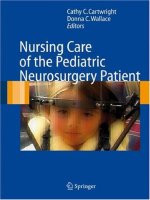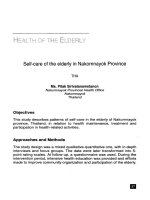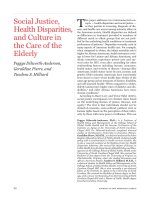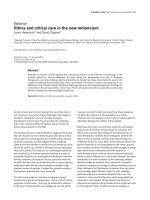Pediatric critical care medicine, volume 4 peri operative care of the critically ill or injured child, 2e (2014)
Bạn đang xem bản rút gọn của tài liệu. Xem và tải ngay bản đầy đủ của tài liệu tại đây (12.02 MB, 466 trang )
Derek S. Wheeler
Hector R. Wong
Thomas P. Shanley
Editors
Pediatric Critical
Care Medicine
Volume 4:
Peri-operative Care
of the Critically Ill or
Injured Child
Second Edition
123
Pediatric Critical Care Medicine
Derek S. Wheeler • Hector R. Wong
Thomas P. Shanley
Editors
Pediatric Critical
Care Medicine
Volume 4: Peri-operative Care
of the Critically Ill or Injured Child
Second Edition
Editors
Derek S. Wheeler, MD, MMM
Division of Critical Care Medicine
Cincinnati Children’s Hospital Medical Center
University of Cincinnati College of Medicine
Cincinnati, OH
USA
Thomas P. Shanley, MD
Michigan Institute for Clinical and Health Research
University of Michigan Medical School
Ann Arbor, MI
USA
Hector R. Wong, MD
Division of Critical Care Medicine
Cincinnati Children's Hospital Medical Center
University of Cincinnati College of Medicine
Cincinnati, OH
USA
ISBN 978-1-4471-6358-9
ISBN 978-1-4471-6359-6
DOI 10.1007/978-1-4471-6359-6
Springer London Heidelberg New York Dordrecht
(eBook)
Library of Congress Control Number: 2014938035
© Springer-Verlag London 2014
This work is subject to copyright. All rights are reserved by the Publisher, whether the whole or part of the material is
concerned, specifically the rights of translation, reprinting, reuse of illustrations, recitation, broadcasting, reproduction
on microfilms or in any other physical way, and transmission or information storage and retrieval, electronic adaptation,
computer software, or by similar or dissimilar methodology now known or hereafter developed. Exempted from this
legal reservation are brief excerpts in connection with reviews or scholarly analysis or material supplied specifically
for the purpose of being entered and executed on a computer system, for exclusive use by the purchaser of the work.
Duplication of this publication or parts thereof is permitted only under the provisions of the Copyright Law of the
Publisher's location, in its current version, and permission for use must always be obtained from Springer. Permissions
for use may be obtained through RightsLink at the Copyright Clearance Center. Violations are liable to prosecution
under the respective Copyright Law.
The use of general descriptive names, registered names, trademarks, service marks, etc. in this publication does not
imply, even in the absence of a specific statement, that such names are exempt from the relevant protective laws and
regulations and therefore free for general use.
While the advice and information in this book are believed to be true and accurate at the date of publication, neither
the authors nor the editors nor the publisher can accept any legal responsibility for any errors or omissions that may
be made. The publisher makes no warranty, express or implied, with respect to the material contained herein.
Printed on acid-free paper
Springer is part of Springer Science+Business Media (www.springer.com)
For Cathy, Ryan, Katie, Maggie, and Molly
“You don’t choose your family. They are God’s gift to you…”
Desmond Tutu
Foreword to the First Edition
The practitioner of Pediatric Critical Care Medicine should be facile with a broad scope of
knowledge from human developmental biology, to pathophysiologic dysfunction of virtually
every organ system, and to complex organizational management. The practitioner should
select, synthesize and apply the information in a discriminative manner. And finally and most
importantly, the practitioner should constantly “listen” to the patient and the responses to interventions in order to understand the basis for the disturbances that create life-threatening or
severely debilitating conditions.
Whether learning the specialty as a trainee or growing as a practitioner, the pediatric intensivist must adopt the mantle of a perpetual student. Every professional colleague, specialist
and generalist alike, provides new knowledge or fresh insight on familiar subjects. Every
patient presents a new combination of challenges and a new volley of important questions to
the receptive and inquiring mind.
A textbook of pediatric critical care fills special niches for the discipline and the student of
the discipline. As an historical document, this compilation records the progress of the specialty. Future versions will undoubtedly show advances in the basic biology that are most
important to bedside care. However, the prevalence and manifestation of disease invariably
will shift, driven by epidemiologic forces, and genetic factors, improvements in care and,
hopefully, by successful prevention of disease. Whether the specialty will remain as broadly
comprehensive as is currently practiced is not clear, or whether sub-specialties such as cardiacand neurointensive care will warrant separate study and practice remains to be determined.
As a repository of and reference for current knowledge, textbooks face increasing and
imposing limitations compared with the dynamic and virtually limitless information gateway
available through the internet. Nonetheless, a central standard serves as a defining anchor from
which students and their teachers can begin with a common understanding and vocabulary and
thereby support their mutual professional advancement. Moreover, it permits perspective,
punctuation and guidance to be superimposed by a thoughtful expert who is familiar with the
expanding mass of medical information.
Pediatric intensivists owe Drs. Wheeler, Wong, and Shanley a great debt for their work in
authoring and editing this volume. Their effort was enormously ambitious, but matched to the
discipline itself in depth, breadth, and vigor. The scientific basis of critical care is integrally
woven with the details of bedside management throughout the work, providing both a satisfying rationale for current practice, as well as a clearer picture of where we can improve. The
coverage of specialized areas such as intensive care of trauma victims and patients following
congenital heart surgery make this a uniquely comprehensive text. The editors have assembled
an outstanding collection of expert authors for this work. The large number of international
contributors is striking, but speaks to the rapid growth of this specialty throughout the world.
We hope that this volume will achieve a wide readership, thereby enhancing the exchange
of current scientific and managerial knowledge for the care of critically ill children, and stimulating the student to seek answers to fill our obvious gaps in understanding.
Chicago, IL, USA
New Haven, CT, USA
Thomas P. Green
George Lister
vii
Preface to the Second Edition
The specialty of pediatric critical care medicine continues to grow and evolve! The modern
PICU of today is vastly different, even compared to as recently as 5 years ago. Technological
innovations in the way we approach the diagnosis and treatment of critically ill children have
seemingly changed overnight in some cases. Vast improvements in anesthesia and surgical
techniques have resulted in better outcomes and shorter lengths of stay in the PICU. The outcomes of conditions that were, even less than a decade ago, almost uniformly fatal have greatly
improved. Advances in molecular biology have led to the era of personalized medicine – we
can now individualize our treatment approach to the unique and specific needs of a patient. We
now routinely rely on a vast array of condition-specific biomarkers to initiate and titrate therapy. Some of these advances in molecular biology have uncovered new diseases and conditions
altogether! At the same time, pediatric critical care medicine has become more global. We are
sharing our knowledge with the world community. Through our collective efforts, we are
advancing the care of our patients. Pediatric critical care medicine will continue to grow and
evolve – more technological advancements and scientific achievements will surely come in the
future. We will become even more global in scope. However, the human element of what pediatric critical care providers do will never change. “For all of the science inherent in the specialty of pediatric critical care medicine, there is still art in providing comfort and solace to our
patients and their families. No technology will ever replace the compassion in the touch of a
hand or the soothing words of a calm and gentle voice” [1]. I remain humbled by the gifts that
I have received in my life. And I still remember the promise I made to myself so many years
ago – the promise that I would dedicate the rest of my professional career to advancing the field
of pediatric critical care medicine as payment for these gifts. It is my sincere hope that the
second edition of this textbook will educate a whole new generation of critical care professionals, and in so-doing help me continue my promise.
Cincinnati, OH, USA
Derek S. Wheeler, MD, MMM
Reference
1. Wheeler DS. Care of the critically ill pediatric patient. Pediatr Clin North Am 2013;60:xv–xvi. Copied with
permission by Elsevier, Inc.
ix
Preface to the First Edition
Promises to Keep
The field of critical care medicine is growing at a tremendous pace, and tremendous advances
in the understanding of critical illness have been realized in the last decade. My family has
directly benefited from some of the technological and scientific advances made in the care of
critically ill children. My son Ryan was born during my third year of medical school. By some
peculiar happenstance, I was nearing completion of a 4-week rotation in the Newborn Intensive
Care Unit. The head of the Pediatrics clerkship was kind enough to let me have a few days off
around the time of the delivery – my wife Cathy was 2 weeks past her due date and had been
scheduled for elective induction. Ryan was delivered through thick meconium-stained amniotic fluid and developed breathing difficulty shortly after delivery. His breathing worsened
over the next few hours, so he was placed on the ventilator. I will never forget the feelings of
utter helplessness my wife and I felt as the NICU Transport Team wheeled Ryan away in the
transport isolette. The transport physician, one of my supervising third year pediatrics residents during my rotation the past month, told me that Ryan was more than likely going to
require ECMO. I knew enough about ECMO at that time to know that I should be scared! The
next 4 days were some of the most difficult moments I have ever experienced as a parent,
watching the blood being pumped out of my tiny son’s body through the membrane oxygen-
Fig. 1
xi
xii
Preface to the First Edition
Fig. 2
ator and roller pump, slowly back into his body (Figs. 1 and 2). I remember the fear of each
day when we would be told of the results of his daily head ultrasound, looking for evidence of
intracranial hemorrhage, and then the relief when we were told that there was no bleeding. I
remember the hope and excitement on the day Ryan came off ECMO, as well as the concern
when he had to be sent home on supplemental oxygen. Today, Ryan is happy, healthy, and
strong. We are thankful to all the doctors, nurses, respiratory therapists, and ECMO specialists
who cared for Ryan and made him well. We still keep in touch with many of them. Without the
technological advances and medical breakthroughs made in the fields of neonatal intensive
care and pediatric critical care medicine, things very well could have been much different. I
made a promise to myself long ago that I would dedicate the rest of my professional career to
advancing the field of pediatric critical care medicine as payment for the gifts that we, my wife
and I, have been truly blessed. It is my sincere hope that this textbook, which has truly been a
labor of joy, will educate a whole new generation of critical care professionals, and in so-doing
help make that first step towards keeping my promise.
Acknowledgements
With any such undertaking, there are people along the way who, save for their dedication,
inspiration, and assistance, a project such as this would never be completed. I am personally
indebted to Michael D. Sova, our Developmental Editor, who has been a true blessing. He has
kept this project going the entire way and has been an incredible help to me personally throughout the completion of this textbook. There were days when I thought that we would never finish – and he was always there to lift my spirits and keep me focused on the task at hand. I will
be forever grateful to him. I am also grateful for the continued assistance of Grant Weston at
Springer. Grant has been with me since the very beginning of the first edition of this textbook.
He has been a tremendous advocate for our specialty, as well as a great mentor and friend. I
would be remiss if I did not thank Brenda Robb for her clerical and administrative assistance
during the completion of this project. Juggling my schedule and keeping me on time during
this whole process was not easy! I have been extremely fortunate throughout my career to have
had incredible mentors, including Jim Lemons, Brad Poss, Hector Wong, and Tom Shanley.
All four are gifted and dedicated clinicians and remain passionate advocates for critically ill
children, the specialties of neonatology and pediatric critical care medicine, and me! I want to
personally thank both Hector and Tom for serving again as Associate Editors for the second
edition of this textbook. Their guidance and advice has been immeasurable. I have been truly
fortunate to work with an outstanding group of contributors. All of them are my colleagues and
many have been my friends for several years. It goes without saying that writing textbook
chapters is a difficult and arduous task that often comes without a lot of benefits. Their expertise and dedication to our specialty and to the care of critically ill children have made this
project possible. The textbook you now hold in your hands is truly their gift to the future of our
specialty. I would also like to acknowledge the spouses and families of our contributors – participating in a project such as this takes a lot of time and energy (most of which occurs outside
of the hospital!). Last, but certainly not least, I would like to especially thank my family – my
wife Cathy, who has been my best friend and companion, number one advocate, and sounding
board for the last 22 years, as well as my four children – Ryan, Katie, Maggie, and Molly, to
whom I dedicate this textbook and all that I do.
xiii
Contents
Part I
Anesthesia in the Critically Ill or Injured Child
Stephen D. Playfor
1
Preparing the Critically Ill or Injured Child for Surgery . . . . . . . . . . . . . . . . .
Nancy S. Hagerman and Anna M. Varughese
3
2
Pharmacology of Inhalational and Intravenous Anesthetic Agents . . . . . . . . .
David P. Martin and Joseph D. Tobias
11
3
Sedation and Analgesia . . . . . . . . . . . . . . . . . . . . . . . . . . . . . . . . . . . . . . . . . . . . .
Eric Lloyd, Manal Alasnag, and Joseph D. Tobias
31
4
Tolerance, Physical Dependency, and Withdrawal. . . . . . . . . . . . . . . . . . . . . . .
Joseph D. Tobias
63
5
Neuromuscular Blockade . . . . . . . . . . . . . . . . . . . . . . . . . . . . . . . . . . . . . . . . . . .
Paulo Sérgio Lucas da Silva, Henrique Monteiro Neto,
and Werther Brunow de Carvalho
77
6
Procedural Sedation and Anesthesia in the PICU . . . . . . . . . . . . . . . . . . . . . . .
Stephen D. Playfor and Katherine Kirkpatrick
91
7
Blood Conservation in the Perioperative Setting . . . . . . . . . . . . . . . . . . . . . . . .
B. Craig Weldon
103
8
Malignant Hyperthermia . . . . . . . . . . . . . . . . . . . . . . . . . . . . . . . . . . . . . . . . . . .
Thierry Girard and Albert Urwyler
113
Part II
General Principles of Peri-operative Care
Michael R. Anderson
9
Peri-operative Care of the General Pediatric Surgical Patient . . . . . . . . . . . . .
Robert T. Russell, David E. Carney, and Frederick J. Rescorla
119
10
Perioperative Care of the Pediatric Neurosurgical Patient . . . . . . . . . . . . . . . .
Monica S. Vavilala and Sulpicio G. Soriano
141
11
Perioperative Care of the Urology Patient. . . . . . . . . . . . . . . . . . . . . . . . . . . . . .
Carley Riley and Shumyle Alam
167
12
Perioperative Care of the Orthopaedic Surgery Patient . . . . . . . . . . . . . . . . . .
Seirhei Slinko
177
13
Peri-operative Care of the ENT Patient. . . . . . . . . . . . . . . . . . . . . . . . . . . . . . . .
Daisy A. Ciener, Obiageri Ekeh, and Katherine E. Mason
187
xv
xvi
Contents
Part III
Trauma
Richard A. Falcone
14
Head and Neck Trauma. . . . . . . . . . . . . . . . . . . . . . . . . . . . . . . . . . . . . . . . . . . . .
Derek S. Wheeler, Derek Andrew Bruce, and Charles Schleien
199
15
Craniofacial Trauma . . . . . . . . . . . . . . . . . . . . . . . . . . . . . . . . . . . . . . . . . . . . . . .
Brian S. Pan, Haithem E. Babiker, and David A. Billmire
221
16
Thoracic Trauma . . . . . . . . . . . . . . . . . . . . . . . . . . . . . . . . . . . . . . . . . . . . . . . . . .
Ivan M. Gutierrez and David P. Mooney
229
17
Abdominal Trauma . . . . . . . . . . . . . . . . . . . . . . . . . . . . . . . . . . . . . . . . . . . . . . . .
Pleun E.A. Hermsen, Rene M.H. Wijnen, and Ivo de Blaauw
237
18
Genitourinary Trauma . . . . . . . . . . . . . . . . . . . . . . . . . . . . . . . . . . . . . . . . . . . . .
Shumyle Alam and Daniel Robertshaw
249
19
Pediatric Orthopaedic Trauma. . . . . . . . . . . . . . . . . . . . . . . . . . . . . . . . . . . . . . .
Charles T. Mehlman and Alvin H. Crawford
263
20
Pediatric Burns. . . . . . . . . . . . . . . . . . . . . . . . . . . . . . . . . . . . . . . . . . . . . . . . . . . .
Itoro E. Elijah, Spogmai Komak, Celeste C. Finnerty, and David N. Herndon
277
Part IV
21
Cardiac Surgery and Critical Care
Bradley S. Marino
The Systemic Inflammatory Response to Cardiopulmonary Bypass:
Pathophysiology and Treatment . . . . . . . . . . . . . . . . . . . . . . . . . . . . . . . . . . . . . .
Ronald A. Bronicki and Mark S. Bleiweis
289
22
Myocardial Protection . . . . . . . . . . . . . . . . . . . . . . . . . . . . . . . . . . . . . . . . . . . . . .
Aaron W. Eckhauser and Thomas L. Spray
297
23
Surgical Interventions for Congenital Heart Disease . . . . . . . . . . . . . . . . . . . . .
Stephanie Fuller, Bradley S. Marino, and Thomas L. Spray
303
24
Palliative Procedures . . . . . . . . . . . . . . . . . . . . . . . . . . . . . . . . . . . . . . . . . . . . . . .
Thomas B. Do, Mark A. Scheurer, and Andrew M. Atz
323
25
Peri-operative Care of the Child with Congenital Heart Disease . . . . . . . . . . .
Alejandro A. Floh, Catherine D. Krawczeski, and Steven M. Schwartz
329
Part V
Critical Care of the Solid Organ Transplant Patient
Denis Devictor
26
Pharmacology of Immunosuppression. . . . . . . . . . . . . . . . . . . . . . . . . . . . . . . . .
John F. Sommerauer, Andrea R. Chamberlain, and Trina Devadhar Hemmelgarn
355
27
Heart Transplantation . . . . . . . . . . . . . . . . . . . . . . . . . . . . . . . . . . . . . . . . . . . . . .
Clifford Chin and John Lynn Jefferies
387
28
Pediatric Lung Transplantation . . . . . . . . . . . . . . . . . . . . . . . . . . . . . . . . . . . . . .
Renee Potera and Charles B. Huddleston
401
29
Pediatric Liver Transplantation . . . . . . . . . . . . . . . . . . . . . . . . . . . . . . . . . . . . . .
Denis Devictor and Pierre Tissieres
411
Contents
xvii
30
Intestinal/Multivisceral Transplantation . . . . . . . . . . . . . . . . . . . . . . . . . . . . . . .
Gwenn E. McLaughlin and Tomoaki Kato
425
31
Kidney Transplantation. . . . . . . . . . . . . . . . . . . . . . . . . . . . . . . . . . . . . . . . . . . . .
Coral D. Hanevold, Travis R. Langner, Atsushi Aikawa, Takeshi Kawamura,
Takashi Terada, and Derek S. Wheeler
443
Index . . . . . . . . . . . . . . . . . . . . . . . . . . . . . . . . . . . . . . . . . . . . . . . . . . . . . . . . . . . . . . . .
455
Contributors
Atsushi Aikawa, MD, PhD Department of Nephrology,
Toho University Omori Medical Center, Tokyo, Japan
Shumyle Alam, MD Division of Pediatric Urology, Columbia University Medical Center,
Morgan Stanley Children’s Hospital, New York, NY, USA
Manal Alasnag, AB, MBBCh, MRCPCH(UK) Assistant Professor of Pediatrics,
Head of Pediatric Intensive Care Unit, King Fahd Armed Forces Hospital, King Abdulaziz
University Jeddah, Jeddah, Saudi Arabia
Andrew M. Atz, MD Department of Pediatrics,
Medical University of South Carolina, Charleston, SC, USA
David A. Billmire, MD Division of Pediatric Plastic Surgery,
Cincinnati Children’s Hospital Medical Center, Cincinnati, OH, USA
Mark S. Bleiweis, MD Department of Surgery and Pediatrics,
University of Florida, Gainesville, FL, USA
Ronald A. Bronicki, MD Cardiovascular Intensive Care Unit,
Texas Children’s Hospital, Baylor College of Medicine, Houston, TX, USA
Derek Andrew Bruce, MB, ChB Center for Neuroscience and Behavioral Medicine,
Children’s National Medical Center, Washington, DC, USA
David E. Carney, MD Division of Pediatric Surgery,
Mercer School of Medicine, Savannah, Georgia, USA
Andrea R. Chamberlain, PharmD Department of Pharmacy,
Cincinnati Children’s Hospital Medical Center, Cincinnati, OH, USA
Clifford Chin, MD Pediatric Heart Transplant Services, The Heart Institute,
Cincinnati Children’s Hospital Medical Center, Cincinnati, OH, USA
Daisy A. Ciener, MD Department of Pediatrics, Medical College of Wisconsin,
Children’s Hospital of Wisconsin, Milwaukee, WI, USA
Alvin H. Crawford, MD, FACS Department of Orthopaedic Surgery,
University of Cincinnati Health Center, Cincinnati, OH, USA
Paulo Sérgio Lucas da Silva, MD, MsC Pediatric Intensive Care Unit,
Department of Pediatrics, Hospital do Servidor Publico Municipal, São Paulo, Brazil
Ivo de Blaauw, MD, PhD Department of Pediatric Surgery,
Erasmus MC Sophia Childrens Hospital, Rotterdam, Zuid-Holland, Netherlands
Werther Brunow de Carvalho, PhD Pediatric Intensive Care Unit/Division of
Neonatology, Department of Pediatrics, Hospital das Clínicas da Faculdade de
Medicina da Universidade de São Paulo, São Paulo, Brazil
xix
xx
Denis Devictor, MD, PhD Department of Pediatrics, Hôpitaux Universitaires Paris Sud,
Hôpital de Bicêtre. University Paris 11-Sud, Le Kremlin-Bicêtre, France
Thomas B. Do, MD Department of Pediatrics,
Medical University of South Carolina, Charleston, SC, USA
Aaron W. Eckhauser, MD, MSCI Department of Pediatric Cardiothoracic Surgery,
University of Utah and Primary Children’s Medical Center, Salt Lake City, UT, USA
Obiageri Ekeh, MD, MBBS Pediatric ICU, Summerlin Hospital, Las Vegas, NV, USA
Haithem Elhadi, MD Division of Plastic, Reconstructive, Hand and Burn Surgery,
University of Cincinnati Health, Cincinnati, OH, USA
Itoro E. Elijah, MD, MPH Department of Surgery, University of Texas Medical
Branch – Galveston, Galveston, TX, USA
Celeste C. Finnerty, PhD Department of Surgery, Shriners Hospitals for Children,
Institute for Translational Sciences, and Sealy Center for Molecular Medicine
at the University of Texas Medical Branch, Galveston, TX, USA
Alejandro A. Floh, MD Department of Critical Care, Hospital for Sick Children,
Toronto, ON, Canada
Stephanie Fuller, MD, MS Department of Cardiothoracic Surgery,
Children’s Hospital of Philadelphia, Philadelphia, PA, USA
Thierry Girard, MD Department of Anesthesia, University Hospital, Basel, Switzerland
Ivan M. Gutierrez, MD Department of General Surgery,
Children’s Hospital Boston, Boston, MA, USA
Nancy S. Hagerman, MD Department of Anesthesia,
Cincinnati Children’s Hospital Medical Center, Cincinnati, OH, USA
Coral D. Hanevold, MD Division of Nephrology, Department of Pediatrics,
Seattle Children’s Hospital, Seattle, WA, USA
Trina Devadhar Hemmelgarn, PharmD Division of Pharmacy,
Cincinnati Children’s Hospital Medical Center, Cincinnati, OH, USA
Pleun E.A. Hermsen, MD Department of Pediatric Surgery,
Erasmus MC Sophia Childrens Hospital, Rotterdam, Zuid-Holland, Netherlands
David N. Herndon, MD, FACS Department of Surgery,
University of Texas Medical Branch – Galveston, Galveston, TX, USA
Charles B. Huddleston, MD Department of Cardiothoracic Surgery,
Cardinal Glennon Children’s Hospital, St. Louis, MO, USA
Department of Surgery, Saint Louis University School of Medicine, St. Louis, MO, USA
John Lynn Jefferies, MD, MPH Division of Cardiology,
Cincinnati Children’s Hospital Medical Center, Cincinnati, OH, USA
Tomoaki Kato, MD Department of Surgery,
Columbia University Medical Center, New York, NY, USA
Takeshi Kawamura, MD, PhD Department of Nephrology,
Toho University Omori Medical Center, Tokyo, Japan
Katherine Kirkpatrick, MBChB, FRCA Department of Paediatric Anaesthesia,
Royal Manchester Children’s Hospital, Manchester, UK
Contributors
Contributors
xxi
Spogmai Komak, MD Department of Anesthesiology, UTMB, Shriners Hospitals
for Children & University of Texas Medical Branch, Galveston, TX, USA
Catherine D. Krawczeski, MD Division of Pediatric Cardiology,
Stanford University School of Medicine, Palo Alto, CA, USA
Travis R. Langner, MD Department of Critical Care,
Cincinnati Children’s Hospital Medical Center, Cincinnati, OH, USA
Eric Lloyd, MD Department of Critical Care Medicine,
Nationwide Children’s Hospital, Columbus, OH, USA
Bradley S. Marino, MD, MPP, MSCE Divisions of Cardiology and Critical Care Medicine,
Department of Pediatrics, Cincinnati Children’s Hospital Medical Center, Cincinnati, OH, USA
David P. Martin, MD Department of Anesthesiology & Pain Medicine,
Nationwide Children’s Hospital, Columbus, OH, USA
Katherine E. Mason, MD Department of Pediatrics,
Rainbow Babies Children’s Hospital, Cleveland, OH, USA
Gwenn E. McLaughlin, MD, MSPH Holtz Children’s Hospital/Jackson Health System,
University of Miami Miller School of Medicine, Miami, FL, USA
Charles T. Mehlman, DO, MPH Department of Pediatric Orthopaedics,
Cincinnati Children’s Hospital Medical Center, Cincinnati, OH, USA
David P. Mooney, MD, MPH Department of General Surgery,
Children’s Hospital Boston, Boston, MA, USA
Henrique Monteiro Neto, MD Emergency Department,
Hospital Israelita Albert Einstein, Barueri, SP, Brazil
Brian S. Pan, MD Division of Pediatric Plastic Surgery,
Cincinnati Children’s Hospital Medical Center, Cincinnati, OH, USA
Stephen D. Playfor, MBBS, DCH, MRCP, MRCPCH, DM Paediatric Intensive Care Unit,
Royal Manchester Children’s Hospital, Manchester, UK
Renee Potera, MD Department of Pediatrics, Saint Louis Children’s Hospital,
St. Louis, MO, USA
Frederick J. Rescorla, MD Division of Pediatric Surgery, Indiana University School
of Medicine, Riley Hospital for Children, Indianapolis, IN, USA
Carley Riley, MD, MPP Department of Critical Care Medicine,
Cincinnati Children’s Hospital Medical Center, Cincinnati, OH, USA
Daniel Robertshaw, MD Department of Urology, University of Cincinnati,
Cincinnati, OH, USA
Robert T. Russell, MD, MPH Division of Pediatric Surgery,
Indiana University School of Medicine, Riley Hospital for Children,
Indianapolis, IN, USA
Children’s of Alabama, University of Alabama at Birmingham, Birmingham, AL, USA
Mark A. Scheurer, MD, MSc, FACC Department of Pediatrics,
Medical University of South Carolina, Charleston, SC, USA
Charles Schleien, MD, MBA Department of Pediatrics, Cohen Children’s Medical Center,
Hofstra North Shore-LIJ School of Medicine, New Hyde Park, NY, USA
xxii
Steven M. Schwartz, MD, MS, RCPSC Critical Care Medicine and Pediatrics,
The Hospital for Sick Children, Toronto, ON, Canada
Seirhei Slinko, MD, PhD PICU, Cardon Children’s Medical Center, Mesa, AZ, USA
John F. Sommerauer, MD, FRCPC Department of Pediatrics,
Children’s Mercy Hospital and Clinics, Kansas City, MO, USA
Sulpicio G. Soriano, MD Department of Anesthesiology, Perioperative and Pain Medicine,
Children’s Hospital Boston, Harvard Medical School, Boston, MA, USA
Thomas L. Spray, MD Division of Pediatric Cardiothoracic Surgery,
The Children’s Hospital of Philadelphia, Philadelphia, PA, USA
Takashi Terada, MD, PhD Department of Anesthesiology,
Toho University Omori Medical Center, Tokyo, Japan
Pierre Tissieres, MD, PhD Department of Pediatrics, Hôpitaux Universitaires Paris Sud,
Hôptal de Bicêtre. University Paris 11-Sud, Le Kremlin-Bicêtre, France
Joseph D. Tobias, MD Department of Anesthesiology & Pain Medicine,
Nationwide Children’s Hospital, Columbus, OH, USA
Albert Urwyler, MD Department of Anesthesia, University Hospital, Basel, Switzerland
Anna M. Varughese, MD, MPH Department of Anesthesiology,
Cincinnati Children’s Hospital Medical Center, Cincinnati, OH, USA
Monica S. Vavilala, MD Department of Anesthesiology and Pain Medicine,
Harborview Medical Center, Seattle, WA, USA
B. Craig Weldon, MD Department of Anesthesiology and Pediatrics,
Duke University Hospital, Durham, NC, USA
Derek S. Wheeler, MD, MMM Division of Critical Care Medicine,
Cincinnati Children’s Hospital Medical Center, University of Cincinnati College of
Medicine, Cincinnati, OH, USA
Rene M.H. Wijnen, MD, PhD Department of Pediatric Surgery,
Erasmus MC Sophia Children’s Hospital, Rotterdam, Zuid-Holland, Netherlands
Contributors
Part I
Anesthesia in the Critically Ill or Injured Child
Stephen D. Playfor
1
Preparing the Critically Ill or Injured
Child for Surgery
Nancy S. Hagerman and Anna M. Varughese
Abstract
The identification and assessment of perioperative risk factors in the critically ill child
requiring surgery is important, because targeting these risk factors allows the creation of
care plans that can significantly improve outcomes. This chapter provides an overview of
the preoperative assessment and preparation of these patients for surgery. It reviews fasting
guidelines, provides a systems-approach to the preoperative assessment, administration of
preoperative medications, and determination of which preoperative laboratory or radiological data to attain. Appropriate access and monitoring, risk involved in the transportation
process, reducing surgical site infections in the pediatric patient, and the importance of
effective multidisciplinary communication and communication with patients and their families is also addressed.
Keywords
Preoperative assessment • ICU • Critical care • Pediatric anesthesia • Preoperative
evaluation
Introduction
Although the incidence of intraoperative death associated with
anesthesia has declined dramatically over the past several
decades, perioperative morbidity and mortality in critically ill
patients continues to be high, particularly in those patients
who exhibit known risk factors. An individual patient’s perioperative risk includes both surgical as well as anesthetic risks
associated with their underlying disease state. Established risk
N.S. Hagerman, MD (*)
Department of Anesthesia,
Cincinnati Children’s Hospital Medical Center,
3333 Burnet Avenue, MLC 2001, Cincinnati,
OH 45229-3039, USA
e-mail:
A.M. Varughese, MD, MPH
Department of Anesthesiology,
Cincinnati Children’s Hospital Medical Center,
MLC 2001, 3333 Burnet Avenue, Cincinnati,
OH 45229-3039, USA
e-mail:
D.S. Wheeler et al. (eds.), Pediatric Critical Care Medicine,
DOI 10.1007/978-1-4471-6359-6_1, © Springer-Verlag London 2014
factors in the pediatric population include a higher ASA physical status (a classification system used to describe a patient’s
physical state ranging from 1 to 6) (Table 1.1), age (especially
those patients under 1 year), emergency surgery, existence of
an underlying disease and type of disease, and location of the
intervention (operating room vs. non-operating room) [1].
Due to the continual evolution of the practice of medicine, a
comprehensive and accurate assessment of a patient’s perioperative risk can be difficult. However, it is important to target
those factors that can be identified for intervention, because in
so doing, the associated risk can be decreased [2]. This chapter
will focus on those factors for which intervention can be performed to optimize outcomes in the critically ill child preparing for surgery.
Fasting Guidelines
In 2011, the American Society of Anesthesiologists updated
their guidelines for preoperative fasting to reduce the risk of
pulmonary aspiration in patients presenting for surgery [3].
3









